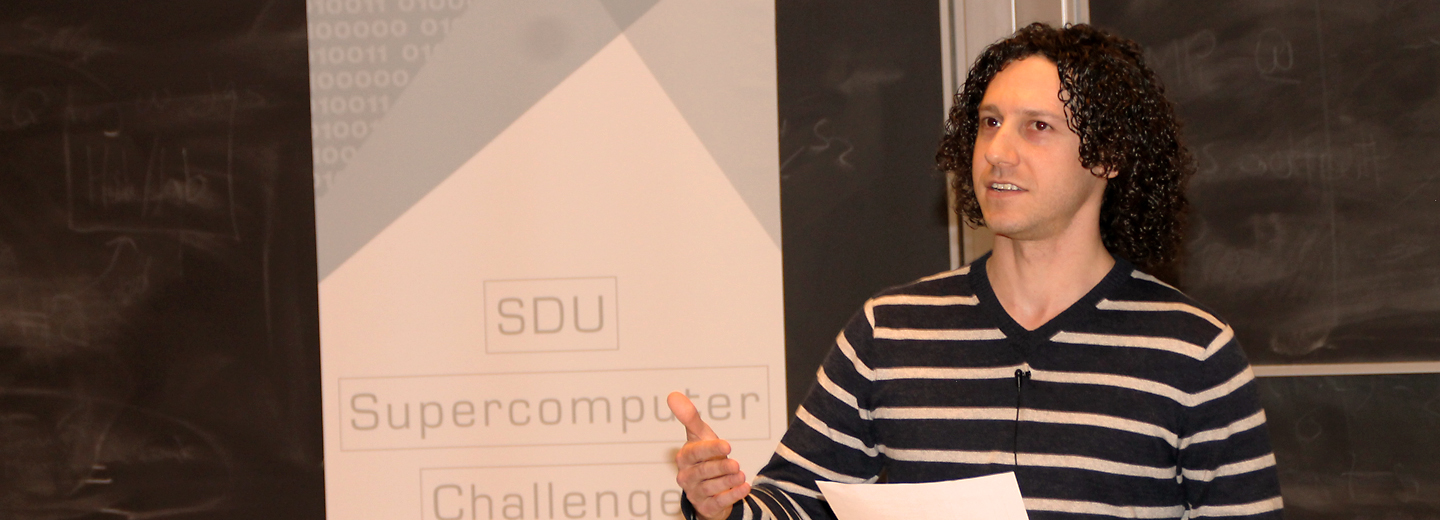
SDU Supercomputer Challenge 2015 was a big success
Four groups of young people from different upper secondary schools were rewarded DKK 25,000 each for winning the SDU Supercomputer Challenge on 1 April. Naturally, the young people where happy to receive the money, however, they were even more proud of their projects, which will be run on SDU's supercomputer, Abacus 2.0, later on.
With the final, the crowning of the winning projects, and the awarding of the prizes, the whole of the project
SDU Supercomputer Challenge was concluded nicely after the start back in November 2015.
And it is with a big smile that the happy project manager Peter Bækgaard Madsen can now lean back a little in the office chair for a moments rest while he looks back on a successful pilot project that is not only the first of its kind at SDU, but in the country.
At the same time, Peter Bækgaard Madsen, along with the other project magager, Professor WSR Claudio Pica, said that with the SDU Supercomputer Challenge, a wide interest in executing similar projects was created.
Real "problems"
The goal of the SDU Supercomputer Challenge was to give young pupils and students the opportunity to work with real tasks and challenges in the form of complex problems from companies and businesses. By matching the young people with companies, not only new contacts and models for cooperation and exchange are established, the young people are also given the opportunity to test themselves on "the real McCoy" while the companies can get help to solve problems that might not otherwise be solved.
With a crucial contribution from the A.P. Møller Foundation, it became possible to see the project through, which made things hectic in the beginning when around 150 companies were contacted while 60 upper secondary schools were visited and the offer of participation was presented.
A total of 168 young people from 21 different educational institutions in the Region of Southern Denmark showed up for the first workshop and introduction day on 5 November 2015. By the end of the day, 27 work groups had been formed who commenced the work of solving complex problems for a total of seven companies.
Ready for a new round
After several workshops, programming courses, and other targeted activities, six work groups could present their solutions to a panel of judges at the day of the finale where the head of the SDU eScience Centre, Professor WSR Claudio Pica, gave a speech to the young people.
"It was not easy. We wanted to aim high, and it was a success. However, we are even more pleased to see what you have accomplished. I've seen you make huge efforts, and not least for this reason, we are all very proud of you," said the physicist who along with Peter Bækgaard Madsen were the coordinators on the entire project.
Peter Bækgaard Madsen, one of the project managers for SDU Supercomputer Challenge , who is also chairman of the Mathematics Association Logimondo, is also both proud and happy that it was concluded with success, and he says:
"At upper secondary schools, you usually receive assignments to which there is already a solution. The whole core of our project is that there is no solution yet – that is what you will have to find. Along the way, the young people were really allowed to show what they can do," he says and points to the coding course in the programming language "Python" as a good example of the tenacity that the young participants displayed.
"I am impressed. They went through almost three months of syllabus in a weekend - that speaks volumes of how motivated they were,” says Peter Bækgaard Madsen, who hoped that they may repeat the success and see a new Supercomputer Challenge through, perhaps already this year. At present, five companies have already committed to participating if a version two comes into existence.
Budding scientists
The four winning groups ended up having found solutions to problems for Fynbus/Movia and the Danish State Archives, respectively. For Fynbus/Movia, the assignment was to optimise and streamline the company's selection of suppliers for tendered jobs. The Danish State Archives wanted a solution that could help them sort and analyse data from many different sources, so they could present an image as accurate as possible of the population in the country in 1786-1880 in this way.
The only thing remaining is that the solutions developed by the young winnersmust now run on Abacus 2.0 during July and August, and all parties involved are looking forward to seeing the results, of course. That will also be the conclusion of the SDU Supercomputer Challenge 2015 that, as an innovative and inspiring project, motivated the Dean of the Faculty of Science, Martin Zachariasen, to say the following to the young winners:
"I myself am a computer scientist, and I can tell you that it was not until I was 3-4 years into my education that I was presented with having to solve as hard and as complex problems as the ones you were presented with here. You are budding scientists," a very happy dean said.